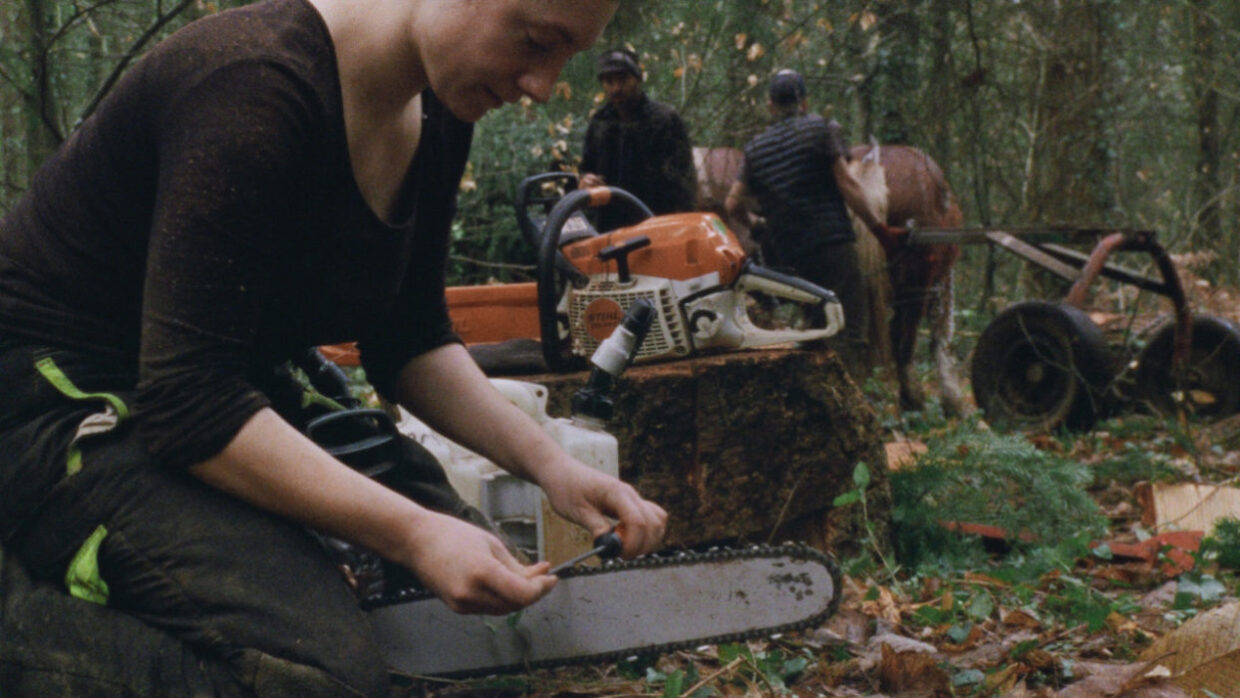 Back to selection
Back to selection
Revolution and TikTok Stick Nation: On Ben Russell and Guillaume Cailleau’s DIRECT ACTION
 Direct Action
Direct Action A TikTok trend called “Stick Nation” has become one of my favorites. Folks around the world introduce themselves with a simple “what’s up, Stick Nation?,” then present a stick they’ve found. We’ll usually get to hear where they found said stick and if it’s oak, birch or pine. Over the past few weeks, sticks were my route to escapism until I saw a more meaningful use for them in Ben Russell and Guillaume Cailleau’s DIRECT ACTION.
The movie begins with a desktop screen as we start to jump back and forth between protests from 2016 and 2018 in Notre-Dames-des-Landes. Since 1970, the French government had plans of developing an airport there, garnering a diverse and large rassemblement of enemies including but not limited to environmental activists, members of the Confédération Paysanne (a French agricultural union) and local citizens invested in stopping the construction. Several hundred people still live on the ZAD today, which successfully managed to prevent the project development in January 2018. The computer screen shows a file called “The Stick March” dated October 10th, 2016. On that day, 40,000 people gathered, abiding by the following sermon: “On this October 8, we’re taking up our sticks, a symbol of our determination and a tool for protecting this ZAD we love. By planting them today, we seal in the soil of Notre-Dame-des-Landes our collective oath to return, if necessary, to defend the ZAD.”
ZAD stands for “Zone à Defendre” (Zone To Defend), a term that re-appropriates the official government acronym: “zone d’aménagement différé” (designated development area). In a similar way, Russell and Cailleau reappropriate the term direct action, often assumed to prefigure violent demonstrations. One could expect the film to focus on altercations between protesters and the police; instead, it mostly portrays tender and tedious moments of the revolution. In one of the first scenes, a woman reads out loud a text on how to navigate different police interrogation tactics without giving away any information. When she’s done, the camera shifts to reveal her interlocutor: a pig. The woman walks over to scratch the pig, whispering sweet nothings into her ear. A lighthearted and upbeat tone is established here, along with humorous deceit. The film leads us to conclude that direct action exists mainly in the everyday lives of the community: in birthday parties, the kneading of bread, the seed sowing and other moments of celebration, collaborative, playful work and, of course, leisure.
DIRECT ACTION strikingly allows all the tasks of the quotidian equal weight on the road to a better, freer world. The film isn’t just an infinitely pleasant experience— it’s also incredibly refreshing to see images of resistance that are hopeful, generative and optimistic, almost contagiously so. The enchantment is produced by their commitment to bringing our attention to the everyday gestures of care, many of which have to do with the land they’re protecting, but also are for a community. As tear gas envelops protesters on a field approaching a gendarmerie truck, one walks by and notices the 16mm camera facing her. She looks upset: “This isn’t what you should be filming,” she says. Although this happens towards the end of the film, it feels like everything preceding is in response to her comment.
The choice to make on-screen subjects anonymous is a significant one. While some faces are shown, hands and tools take on the roles of protagonists: one woman piercing another’s ear, two hands playing a game of chess, a man preparing huge piles of gallettes, flipping eight of them in a row. During a post-protest press conference, several members are insistent on the diverse nature of the ZAD, which garners people from all walks of life and political backgrounds. I couldn’t help but think of The Invisible Committee and their 2014 text To Our Friends “Who’s cooking meals for a thousand persons? Who’s doing the radio? Who’s writing the communiqués? Who’s catapulting rocks at the cops? Who’s building a house? Who’s cutting wood? Who’s speaking in the assembly? We don’t know, and don’t give a fuck: all of that is a force with no name.” More than taking anonymity as a constraint, Russell and Cailleau illustrate this force with no name, taking horizontal forms of power seriously.
Most documentary films on political or environmental activism seek to provoke outrage or simply raise awareness to an issue but tend to leave me with tremendous and paralyzing dread. Instead, after seeing DIRECT ACTION, I was convinced that life—in all of its forms—is valuable and worth fighting for. Similar to the Zadists, the film invites us to collectively imagine a better world, and I found their portrayal of the ZAD particularly moving due to its simplicity. While in the film, sticks are a symbol for land defense; in the TikTok imaginary, they remain tied to the idea of a nationhood. I’m drawing from my personal critical perspectives on the State and my attempts at finding a like-minded, committed community when I say that organizing is tremendously exhausting and usually fails to perdure. Unfortunately, as I’ve moved around in my adult life, I’ve noticed staying in one place makes for a fertile soil for when it comes to organizing. I’m hopeful to see this film as a fruitful invitation, one that could resonate with the Stick Nations of the internet so that they might find each other in their appreciations of life and their desire to build a better world.
DIRECT ACTION premiered at the Berlinale and recently screened at the NYFF as part of the Currents section.
